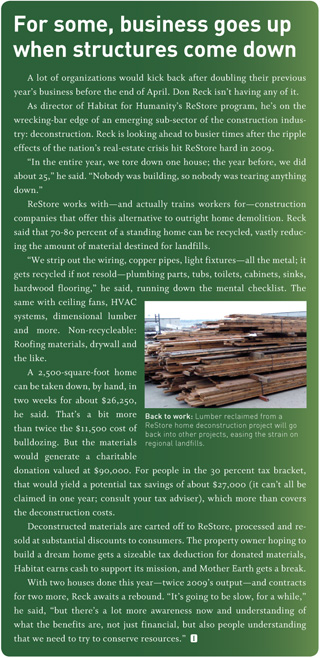So, no, we haven’t reached a point where you can flip a switch and have the sun power your business. But that doesn’t mean you can’t use the sun—or a few less-remote gadgets and tactics—to achi-eve a stronger bottom line.
Let’s start with solar power. Technological advances in recent years have driven down the cost of materials in solar systems, increased their efficiency, and given it a competitive position—it’s too soon to call it a competitive edge—with traditional sources of power.
“The technology is getting to the point where it can be cost-effective in lots of markets, especially when it’s bundled with 15- to 20-year performance contracts,” said Bill Guiney, program manager for renewable solutions at Milwaukee-based Johnson Controls, Inc.
Susan Brown, of the Energy Savings Store in Lenexa, agreed that the cost differential was closing. How much more must the technology advance to make solar the right choice for businesses? “Not much,” Brown said. “If you look at the cost of solar electricity for businesses in KCP&L’s Missouri service territory over the 30-year life of the equipment, the cost is comparable to retail electricity from coal.”
And, she said, as we see more improvements in the structure of power-purchase agreements and lease arrangements, adoption of solar will increase.
It’s important, energy-sector professionals say, to keep the uses of solar power in perspective. The sun’s energy won’t help much if your business is a zinc-smelting operation, and you’re probably not going to use it to go off the utility grid. But for many businesses, the technology in place can—emphasis on “can”—indeed help cut costs by using solar energy to reduce electricity consumed when rates are at their highest.
“At this point, going off-the grid for buildings isn’t on people’s minds,” said Guiney. “The real issue is on reducing peak loads.”
And that, say energy-efficiency experts, is a big piece of the puzzle that business owners need to put together in attacking their energy costs. Solar power, they say, can be part of a broader strategy that relies not just on what the sun can give you, but to supplement such efforts as extending the life and efficiency of some machinery and office equipment, replacing watt-hogging older equipment, upgrading lighting and weatherization, to name just a few standard approaches.
Harvey Buhr, CEO of Jefferson City-based Hitec, was less hopeful of major near-term shifts in the applicability of solar vs. traditional. “I feel we are a long way off before wind and solar can compete with the cost of coal-fired or nuclear-power generation,” he said. “The Callaway plant is now producing power for less than 2 cents (per kilowatt hour), even using their ’50s technology.”
That price point will continue to be a key as those behind the solar revolution attempt to drive down costs.
Where does that all leave us? The cost structure of solar power hasn’t reached a tipping point for decision-makers, and wind-power development has its own challenges in the well-documented lack of transmission-line capacity. Given the state of renewable-energy technologies, Ingram’s put the question to more than a dozen of the region’s best minds in the energy-efficiency and the emerging renewable-energy sector: What are the top three, four or five things that a business owner can do—not next year, but today, even—to make a bottom-line impact on the organization?
Here’s what they had to suggest:
(...continued)

